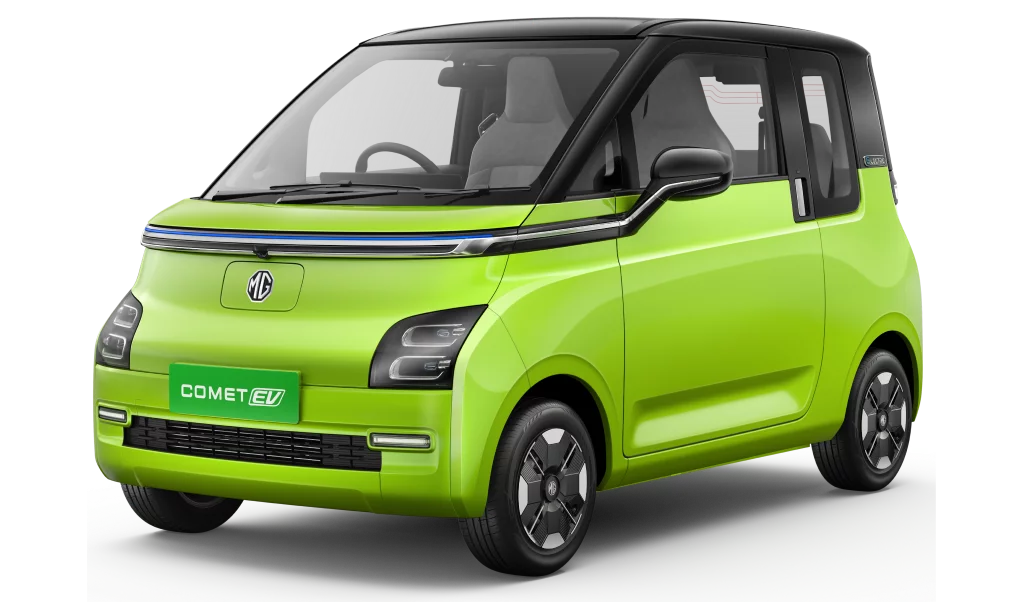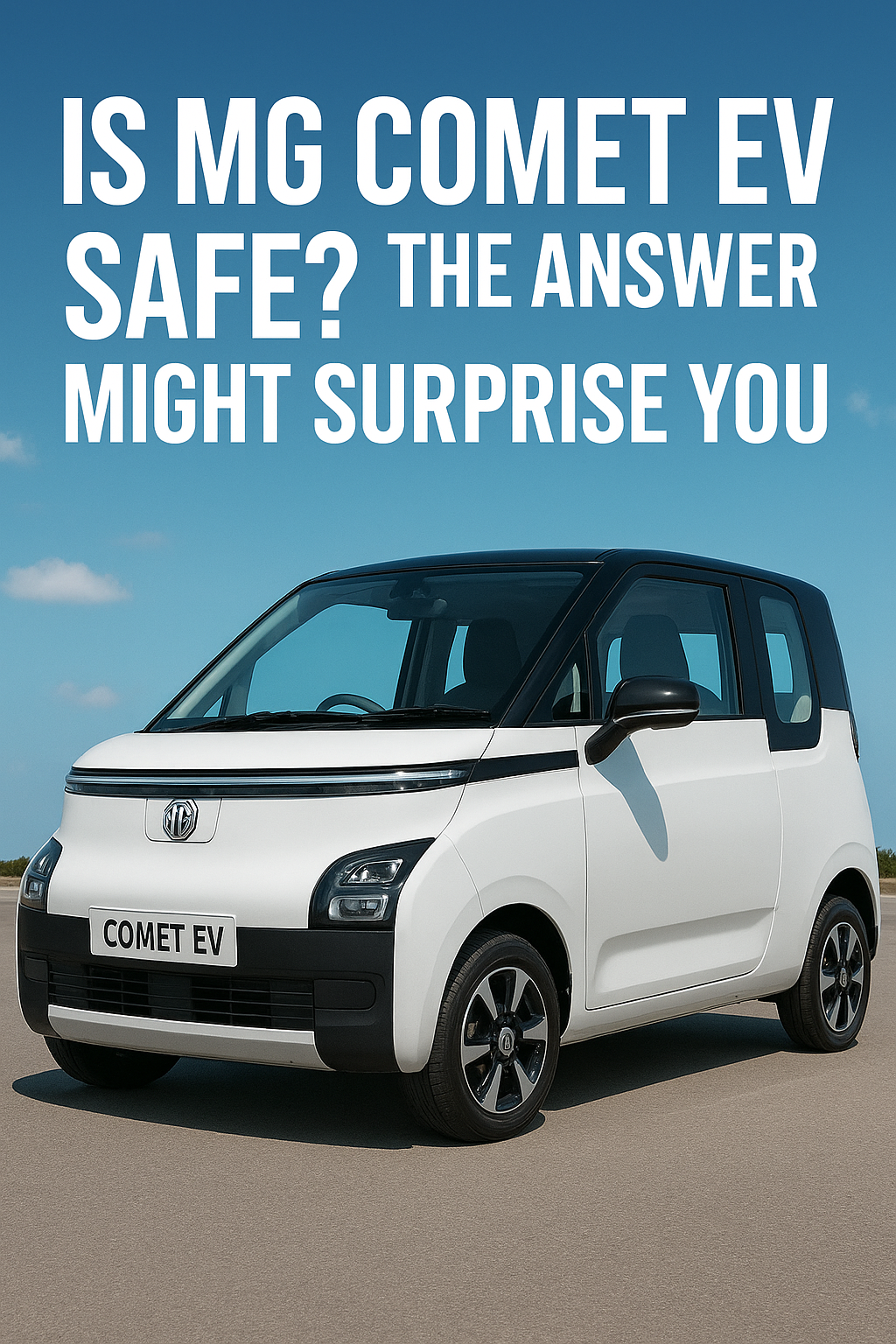When you’re considering a small, city-friendly electric car, one question towers above all others: is the MG Comet EV safe? We’re not just talking about a low-speed runabout; we’re talking about a vehicle that must protect what matters most. So, let’s tackle the big question head-on: Is the MG Comet EV safe? The answer is a fascinating blend of intelligent engineering and clear trade-offs, a story that goes far beyond a simple yes or no.
Is the MG Comet EV safe? Decoding the Build and Safety Features
Let’s be crystal clear. The MG Comet EV is not a huge SUV with a tank-like build. It’s a microcar made for a particular urban use, and its safety strategy is expertly adapted to that situation. Because of its distinct size and architecture, which do not conform to the standard testing procedures intended for larger vehicles, it does not receive a traditional star rating from the Global NCAP, not because it is weak.
But MG Motor hasn’t taken any shortcuts. The rigid passenger safety cage, a high-strength body structure intended to absorb and reroute impact energy away from the cabin, serves as the vehicle’s foundation. It comes standard with rear parking sensors, dual front airbags, and ABS with EBD to prevent wheel lock-up during panic braking.
Additionally, it has ISOFIX child seat mounts, which further solidifies its function as a useful city family shuttle. Its safety suite is therefore carefully crafted for the urban jungle it is intended to traverse, making it an exceptionally safe investment for its intended use, even though it may not have been built for high-speed highway collisions.
What Are the Negatives of the MG Comet EV? The Honest Trade-Offs
Since no car is flawless, you have to accept that the Comet’s distinctive design has certain drawbacks. Its size is the most important factor. The rear seats are best suited for kids or infrequent use because adults may find it difficult to access them due to the two doors. Although they help with its extremely tight turning radius, the small 12-inch wheels can feel a little startling over larger potholes and uneven road surfaces.
Additionally, when all seats are up, the boot space is essentially non-existent; you’ll only have enough room for a few grocery bags. The back seats must be folded down if you need to carry more. The interior’s simplicity and the fact that practically all controls are operated via a digital screen may seem a little too basic to some. It is a car that requires you to embrace its philosophy, which trades traditional car comforts and space for extreme efficiency and agility.
Is the MG Comet EV Good for a Long Drive? Setting Realistic Expectations
We have to draw a very clear line here. Asking if the MG Comet EV is good for a long drive is like asking a sprinter if they can run a marathon. The MG Comet EV is an undisputed champion of city commuting. Its real-world range—which we’ll discuss next—and its top speed—which is electronically limited to about 80 km/h—are its main drawbacks. Because of this, driving on highways for extended periods of time—where 100 km/h is the norm—becomes not only uncomfortable but possibly dangerous.
The lack of high-speed stability you’d get from a larger, heavier car is evident, and the cabin, while quiet in the city, can become a little noisy at its highest speed. It’s just not made for that use. For hopping from one nearby town within its range to another? Maybe. For a legitimate, several-hour interstate trip? That is definitely not part of this ingenious urban runabout’s design brief.
What Are the Benefits of the MG Comet EV? Why It’s a Game-Changer
The benefits are the glorious rewards if the drawbacks are the trade-offs. The main advantage is astounding efficiency. With a stated efficiency of 110 km/kWh, driving the Comet is possibly the most economical four-wheel drive option. Practically speaking, this means that your cost per kilometer is far lower than what any gasoline-powered vehicle could ever provide. And then there’s the convenience itself.
Because of its tiny footprint, you can park it anywhere, make U-turns on even the narrowest streets, and slide through impossibly small gaps in traffic. Despite its simplicity, the interior is surprisingly tech-savvy and modern, with a sizable dual-screen setup for the digital console and infotainment. It is a clean, green option for the driver who cares about the environment because it has zero tailpipe emissions. It makes driving in the city less stressful and turns it from a chore into a truly fun and nimble experience.
Which Is the Cheapest EV Car in India? The Price Leader

Being the most economical electric vehicle is a highly sought-after title in the very competitive Indian EV market. That title is currently proudly held by the MG Comet EV. A whole new market segment can now afford electric mobility thanks to its aggressive pricing strategy, which has completely upended the market. It significantly undercuts its closest competitors, which lessens the intimidating initial step of becoming an EV owner. A significant component of its value proposition is its strategic pricing, which positions it as both a smart car and a wise financial choice for city commuters trying to avoid the unstable prices of fossil fuels.
What Is the Range of the MG Comet EV in Real Life? Beyond the Brochure
At 230 kilometres, the official ARAI-certified range is impressive. Real-world numbers, however, are what really count, as any experienced EV driver will tell you. What can you really anticipate, then? The majority of owners report a very attainable range of 180 to 200 kilometres on a full charge when driving in mixed cities with moderate air conditioning use.
You may even approach the ARAI figure if you drive cautiously and maximize regeneration. That number will be lowered, though, by aggressive driving, continuous high speed (if at all possible), and extensive use of air conditioning. It is important to realize that this range is ideal for a weekly commute to the city, as it can easily cover 30 to 40 kilometers per day with plenty of charge left over. Aligning your use with the car’s purpose is more concerning than the number.
What Is the Top Speed of an MG Comet EV? Enough for the City
The maximum speed of the MG Comet EV is about 80 km/h, or 50 mph. This is a purposeful design decision rather than a limitation brought on by subpar engineering. This speed limit is ideal for the car’s urban-focused purpose. This is more than sufficient in urban traffic, where average speeds hardly ever surpass 40–50 km/h.
It controls driver expectations, guarantees maximum efficiency, and shields the battery from the strain of high discharge rates. It strengthens the car’s reputation as a sensible, safe, and incredibly effective urban mobility solution rather than a performance vehicle.
A Quick Glance: How the Comet Stacks Up
| Aspect | Specification | Real-World Takeaway |
| Official Range | 230 km (ARAI) | Ample for a week of city commutes |
| Real-World Range | 180 – 200 km | Achievable with normal driving |
| Top Speed | 80 km/h | Designed for city limits, not highways |
| Charging (0-80%) | 7 hours (Standard 3.3kW AC) | Perfect for an overnight charge at home |
| Key Safety Features | Dual Airbags, ABS, EBD, Rear Sensors | Comprehensive for urban safety |
The Final Verdict: Who is the MG Comet EV for?
Where does that leave us, then, after removing every layer? A masterpiece of focused design is the MG Comet EV. Being everything to everyone is not the goal. It is a very clever, well-executed, and narrowly focused solution to a very specific issue: urban mobility. It is definitely safe for the city commute for which it was designed.
Its shortcomings are just the opposite of its amazing efficiency and agility. The Comet is not just a good option—it’s possibly the most sensible one available if your life consists of negotiating congested city streets, you want to drastically reduce your running expenses, and you don’t often drive on highways. It redefines purpose and value, demonstrating that, in certain situations, selecting the appropriate tool for the task is the safest and most intelligent course of action.
Frequently Asked Questions
1. I keep hearing about its size. Is the MG Comet EV safe for Indian roads?
This is the biggest question, and rightly so. The Comet’s safety is designed specifically for urban driving. It features a strong passenger safety cage, dual front airbags, ABS, and rear parking sensors. While it doesn’t have a standard Global NCAP rating due to its micro-car classification, it’s built to be robust and safe for the city commute it’s designed for. You’ll feel secure from potholes and traffic, but it’s not meant for high-speed highway impacts.
2. What’s the biggest compromise I’ll have to make?
Space and speed. The rear seats are best for children or short trips, and the trunk is tiny unless you fold the seats down. Its top speed is limited to about 80 km/h, making it unsuitable for regular highway travel. You’re trading space and speed for incredible efficiency and agility in the city.
3. Can I take it on the highway at all?
You can, but it’s not the ideal experience. The Comet is happiest at city speeds. On the highway, you’ll be driving at its maximum speed, which can feel strained and noisy compared to larger vehicles. It’s best used for short stints on highways to connect to neighbouring urban areas, not for long, sustained journeys.
4. How much does it really cost to charge?
This is where the Comet shines. It’s incredibly efficient. A full charge at home will cost significantly less than a full tank of petrol—often just a few hundred rupees for a range of about 200 km. It’s one of the most affordable ways to get around on four wheels.
5. Who is the ideal owner of an MG Comet EV?
Think of the Comet as the ultimate city specialist. It’s perfect for:
- Urban commuters with a daily drive under 40 km.
- Families as a second car for school runs and grocery trips.
- Young professionals looking for a stylish, low-cost runabout.
- Anyone who wants to avoid traffic stress and high fuel costs.
6. If not the Comet, what else should I consider?
If you need more space, higher speed, or a more traditional car feel while staying electric, look at options like the Tata Tiago EV or the Citroën eC3. They are more expensive but offer greater versatility. The Comet’s main advantage is its unique focus and lowest entry price.

1 thought on “The Shocking Truth: Is the MG Comet EV safe? The Answer Might Surprise You”